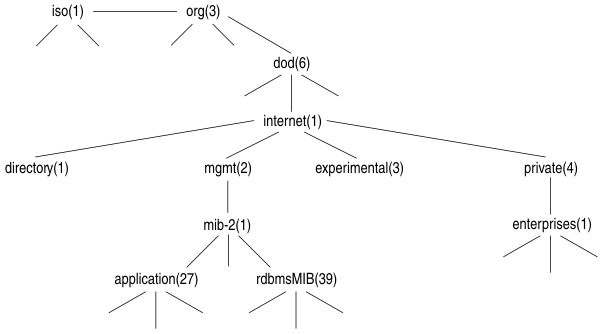
A Management Information Base (MIB) is a group of tables that specify the information that a subagent provides to a master agent. MIBs follow SNMP protocols.
MIBs use a common interface definition language. The Structure of Management Information (SMI) defines this language and dictates how to use Abstract Syntax Notation One (ASN.1) to describe each table in the MIBs.
The name of each MIB table starts with the name of the MIB. Thus each table in the RDBMS MIB starts with rdbms. For example, the RDBMS MIB includes tables that are named rdbmsSrvTable and rdbmsDbInfoTable.
The name of each column in an MIB table starts with the name of the table, excluding Table. Thus, each column in rdbmsSrvTable starts with rdbmsSrv. For example, rdbmsSrvVendorName and rdbmsSrvProductName are columns in rdbmsSrvTable.
All MIBs are part of an information hierarchy that the Internet Assigned Numbers Authority (IANA) defines. The hierarchy defines how to name tables and columns and how to derive the numerical object identifiers (OIDs). Figure 6 shows the MIB hierarchy.

Even though you rarely see the full path to a table, column, or value, the path is important because the SNMP components use the numerical equivalent of the path to locate data. For example, the following value is the path to the Application MIB:
iso.org.dod.internet.mgmt.mib-2.application
An OID is the numerical equivalent of a path. It uniquely describes each piece of data that an SNMP Network Manager can obtain and is written as a string of numbers separated by periods (.). For example, the following value is the OID for the Application MIB:
1.3.6.1.2.1.27
The following value is the OID for a value in the Application MIB:
1.3.6.1.2.1.27.1.1.8.2
The first part of this OID is the OID for the Application MIB. The final part of the OID assigns values sequentially to each table in the MIB, each column in the table, and each value in a column.
Home | [ Top of Page | Previous Page | Next Page | Contents | Index ]